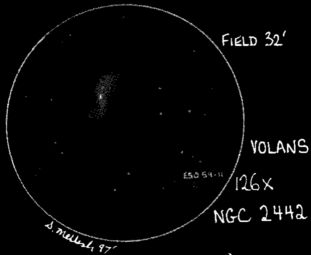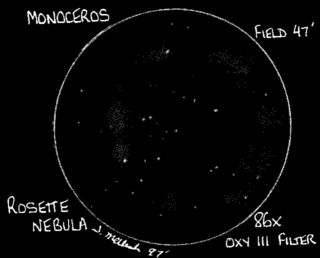SSPM7. February New Moon At Wiruna
By Scott Mellish, 1997
Despite the overcast and unsettled weather during the day, the nights turned out quite good over the February new moon weekend at Wiruna. The Saturday produced the best observing conditions and I managed to finally have a nice long look at NGC 2442 in the constellation of Volans. This object is a spiral galaxy of enormous size which has apparently swallowed up a couple of companions during it's distant past. It was also the topic of the lecture that was given at last years star Party.
 Comparing this galaxy with the Milky Way is somewhat humbling, as it is calculated to be some 3 - 4 times larger than our own modest run-of-the-mill spiral nebula.
Comparing this galaxy with the Milky Way is somewhat humbling, as it is calculated to be some 3 - 4 times larger than our own modest run-of-the-mill spiral nebula.
Observing this object in the eyepiece of the l6inch at 126x shows an 'S' shaped magnitude 11.0 smudge about 6' in length. The overall brightness was very even and subtle wth an almost pin point core punctuating the middle of the object. Despite being a very large spiral it is not a particularly 'stand out' type of object which may lead to either a very large distance or obscuration due to its proximity to the rich Southern Milky Way. None the less, I would rate this as one of the best southern galaxies and an object that is often overlooked. Also in the field as seen in the sketches, is ESO 59.11 - a small featureless smudge about 10' in diameter. An easy object to observe along side NGC 2442 in the l6inch. The two galaxies actually contrast very well together.
There are numerous other small ESO and IC galaxies in the general vicinity and if you have a supernova search chart handy for NGC 2442, I recommend using it to hunt them down.
After observing and sketching the "Meat Hook", as NGC 2442 is known, I went over to see how everyone else was going on the observing field. Don Whiteman was observing the Rosette Nehula in Monoceros and I immediately remembered that this was one object I had been meaning to re-visit for some time. So after some casual discussion over the seeing conditions and what everyone had been observing with their own scopes, I went back to mine and found my way to the Rosette Nebula.
 At 86x magnification and the use of the trusty old OIII filter, this is a wonderful nebula that reminded me vaguely of the Helix Nebula in Aquarius. Mostly for it's large circular shape. The jewel like stars of the open cluster NGC 2244 speckle the central region, with a few situated within the actual outer ring. The OIII filter obviously took the gloss off this cluster, but it brought out more subtle detail in the nebulosity, and careful observation showed a ragged sort of bright and dark rim to the inner edge of the nebula. The open cluster NGC 2244 may contrihute to the relatively clear central region through stellar winds blowing the nebula outwards. The longer you observe this lovely object the more detailed it becomes and at first I baulked at attempting to draw it. But I persevered for some 40 minutes and the end result is about the same as it was in the eyepiece, although darkened somewhat to assist printing for the journal. The Rosette Nebula is an object that deserves more than just a passing glance as proper dark adaptation and averted vision can bring out all sorts of detail.
At 86x magnification and the use of the trusty old OIII filter, this is a wonderful nebula that reminded me vaguely of the Helix Nebula in Aquarius. Mostly for it's large circular shape. The jewel like stars of the open cluster NGC 2244 speckle the central region, with a few situated within the actual outer ring. The OIII filter obviously took the gloss off this cluster, but it brought out more subtle detail in the nebulosity, and careful observation showed a ragged sort of bright and dark rim to the inner edge of the nebula. The open cluster NGC 2244 may contrihute to the relatively clear central region through stellar winds blowing the nebula outwards. The longer you observe this lovely object the more detailed it becomes and at first I baulked at attempting to draw it. But I persevered for some 40 minutes and the end result is about the same as it was in the eyepiece, although darkened somewhat to assist printing for the journal. The Rosette Nebula is an object that deserves more than just a passing glance as proper dark adaptation and averted vision can bring out all sorts of detail.
Clear skies.

